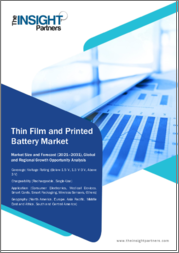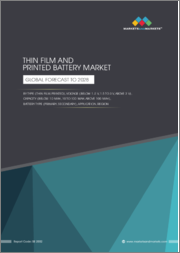
|
시장보고서
상품코드
1273293
세계의 박막 배터리 및 프린티드 배터리 시장 예측(-2028년) : 유형, 용량, 전압, 충전성, 용도, 지역별 분석Thin Film and Printed Battery Market Forecasts to 2028 - Global Analysis By Type, Capacity, Voltage, Rechargeability, Application and By Geography |
||||||
Stratistics MRC에 따르면 세계의 박막 배터리 및 프린티드 배터리(Thin Film and Printed Battery) 시장은 2022년에 1억 4,844만 달러였으며, 2028년에는 5억 8,555만 달러에 달할 것으로 예측되며, 예측 기간 동안 25.7%의 CAGR로 성장할 전망입니다.
박막 배터리는 가볍고 유연하며 보존 기간이 길고 유연한 배터리 팩은 모든 형태와 크기의 제품에 넣을 수 있습니다. 전자 부품의 수요는 저가격, 이동통신이나 인터넷 접속 등 편리성, 그리고 모든 사회경제계층에서 합리적인 가격으로 널리 이용할 수 있기 때문에 최근 몇 년간 크게 성장하고 있습니다. 휴대 전화, 노트북, 카메라, 계산기 등은 전자 기기의 예입니다.
시스코시스템즈에 따르면 스마트워치 출하량은 2020년 1억대를 돌파할 것으로 예측되고 이는 시장 성장을 뒷받침하고 있습니다.
시장 역학 :
촉진 요인
전자기기 소형화의 진전
휴대전화, 시계, 의료기기 등 소형화가 진행되고 있어 소형화된 전자기기 부품의 수요가 증가하고 있습니다. 전세계에서 다양한 소형 전자 시스템 및 장치가 개발되고 있습니다. 종래의 전지에서는 전자기기의 소형화가 곤란하기 때문에, 소형·경량의 프린트 플렉시블 배터리의 수요가 높아지고 있습니다. 의료 기기도 소형화된 배터리로 구동시켜 시장에 투입됩니다. 웨어러블 장비에 통합하려면 얇고 가벼운 배터리가 필요합니다.
제약 :
박막 배터리 및 프린티드 배터리의 개발에 있어서의 표준화의 부족
프린티드 플렉시블 배터리를 만드는 데 사용되는 독특한 기술은 제조업체마다 다르며 제조업체의 기준에 따라 다릅니다. 이러한 배터리는 특정 전자 장치 전용으로 설계되었으므로 다른 장치에 사용하면 호환성 문제가 발생합니다. 그 결과, 전지 개척 시에 따라야 할 기준이 없는 것이 프린티드 플렉시블 배터리 시장의 확대의 제약이 되고 있습니다.
기회
박막 배터리 및 프린티드 배터리를 탑재한 무선 센서의 채택이 증가
IoT와 무선 센서 기술의 향상으로 전세계 무선 센서의 활용이 급속히 진행되고 있습니다. 박막 배터리나 프린트 전지와 같은 에너지 하베스팅 기술은 임베디드 시스템의 전원 공급 옵션으로 급속히 상승하고 있으며, 지금까지 미개척한 용도에서 무선 센서를 사용할 수 있게 되었습니다. 마이크로 배터리는 뛰어난 폼 팩터, 초박형, 저 누설 특성으로 에너지 수확을 실현합니다. 에너지 하베스팅을 이용한 자율형 무선 센서의 도입이 진행되고 있기 때문에, 박막 배터리와 프린트 전지의 시장이 성장할 것으로 예측되고 있습니다.
위협
박막 리튬 이온 배터리 제조의 복잡성
고체 전해질, 소프트 집전체, 전극 재료, 완전한 리튬 이온 배터리 셀 어셈블리의 면밀한 검토가 필요합니다. 그래서 박막 리튬 이온 전지와 프린트 플렉시블 리튬 이온 전지의 기초적인 이해와 시뮬레이션을 실시하는 연구를 진행하고 있습니다. 또한 이러한 배터리의 신뢰성과 성능을 평가하기 위한 연구도 진행되고 있지만, 현재의 첨단 기술로는 쉽게 조사할 수 없습니다. 그 결과, 박막 리튬 이온 배터리 제조의 복잡성은 시장 확대의 큰 장벽이 되었습니다.
COVID-19의 영향 :
박막 배터리 및 프린티드 배터리 시장은, 소비자 전자제품이나 에너지 하베스팅 용도에서의 박막 배터리 및 프린티드 배터리의 채택이 증가해 시장의 성장을 견인하고 있기 때문에, 큰 성장을 이루게 되고 있습니다 . COVID-19의 결과, 판데믹에 따라, 기업이나 세계 경제에 심각한 혼란이 생기기 때문에, 박막 배터리 및 프린티드 배터리의 공급 체인이나 채택이 제한될 것으로 예상되고, 다양한 용도에 있어서의 박막 배터리 및 프린티드 배터리의 기대 성장률은 떨어질 것으로 보입니다.
예측 기간 동안 10 mAh 이하의 부문이 최대가 될 것으로 예상됨
10 mAh 미만의 부문은 유리한 성장을 이룰 것으로 추정됩니다. 10mAh 미만 용량의 배터리는 의료용 임플란트, 화장품용 패치, 사물 인터넷 장비, MEMS, CMOS 메모리 및 기타 저드레인 장비에 자주 사용됩니다. 이러한 장치는 작기 때문에 내부 공간에 한계가 있습니다. 이 장치는 작기 때문에 내부 공간이 제한되어 있으며 저용량 배터리로 구동 할 수 있습니다. 다양한 응용 부문에서 사용되는 박막 및 프린티드 배터리의 수요 증가는 예측 기간 동안 10mAh 미만의 카테고리 개발을 촉진할 것으로 보입니다.
예측 기간 동안 1.5V 미만의 카테고리가 가장 높은 CAGR을 나타낼 것으로 예상됩니다.
1.5V 미만 부문은 소비자 전자 및 기타 소형 가전 제품에 널리 사용되기 때문에 예측 기간 동안 가장 높은 CAGR로 성장할 것으로 예상됩니다. 이 추세는 전세계의 유명한 제조업체들이 이러한 배터리를 보다 작고 안정적이고 안정적으로 만들기 위한 연구개발 노력을 계속하고 있는 결과 향후 수년간 지속될 것으로 예측됩니다. 또한, 보청기, 무선 키보드, 마우스, 도어벨, 무선 보안 시스템의 전원으로 배터리를 사용하는 것도 이 산업의 발전 속도를 높이는 근본적인 이유가 되고 있습니다.
가장 점유율이 높은 지역
예측 기간 동안 북미가 가장 큰 시장 점유율을 차지할 것으로 예측됩니다. 박막 배터리는 소형화로 인해 스마트 워치 및 건강 모니터링 장치과 같은 웨어러블 디바이스에서 유용성이 높으며 미국과 캐나다 고객들로부터 인기가 높습니다. 또한, 이 지역에서는 의료용 전자기기의 이용이 증가하고 있는 것도, 이 시장의 개척을 촉진하는 큰 요인이 되고 있습니다. 이 산업의 주요 제조업체 중 상당수는 Blue Spark Technologies, Ultralife Corporation, Brightvolts Inc. 등 북미에 위치하고 있습니다.
CAGR이 가장 높은 지역 :
아시아 태평양은 예측 기간 동안 가장 높은 CAGR을 나타낼 것으로 예측됩니다. 이 수요의 주요 요인은 2020년을 통해 중국과 일본에서 웨어러블 전자와 보청기, 호흡 보조기 등 의료용 전자기기의 판매가 증가할 것으로 예측되고 있다는 것입니다. 또한, 무선 센서 네트워크, 리모컨, 스마트 카드 등 소비자 가전에 프린티드 배터리 기술의 도입이 증가하고 있는 것도, 이 시장의 성장을 촉진할 것입니다.
주요 발전 동향 :
2020년 3월, Enfucell은 최근 신제품 'Wearable Temperature Tag'를 발표했습니다. 이 태그는 NFC, 지능형 온도 센서, SoftBattery(인쇄지 배터리)의 복합 기술을 기반으로 합니다.
2019년 8월, Imprint Energy는 초박형, 안전하고 플렉시블 프린티드 배터리 개발자용 키트 제공 확대를 발표했습니다. 이 배터리는 단거리 또는 장거리 통신을 위한 전력을 담고 있으며, 특히 블루투스 저에너지 및 기타 표준과 연계하여 저전력 광역 네트워크(LPWAN)용 셈텍 LoRa 디바이스와 통합된 IoT 장치에 전원을 공급하도록 설계되었습니다.
보고서가 제공하는 내용
- 지역 및 국가 수준 부문의 시장 점유율 평가
- 신규 참가 기업에 대한 전략적 제언
- 시장 데이터(2020-2022년, 2025년, 2028년)
- 시장 촉진 요인(시장 동향, 제약 요인, 기회, 위협, 과제, 투자 기회, 권장 사항)
- 시장 추정에 기초한 주요 비즈니스 부문의 전략적 제안
- 주요 공통 추세를 매핑한 경쟁 상황
- 상세한 전략, 재무, 최근 개발 상황을 포함한 기업 개요
- 최신 기술적 진보를 매핑한 공급망 동향
무료 사용자 정의 제공 :
이 보고서를 구입한 고객에게는 다음 무료 맞춤설정 옵션 중 하나를 제공합니다.
- 기업 개요
- 추가 시장 플레이어의 포괄적인 개요(최대 3사까지)
- 주요 플레이어의 SWOT 분석(3사까지)
- 지역별 세분화
- 고객 희망에 따라 주요 국가의 시장 추정 및 예측, CAGR(주 : 타당성 확인에 따라 다름)
- 경쟁 벤치마킹
- 제품 포트폴리오, 지역적 존재, 전략적 제휴에 기초한 주요 플레이어의 벤치마킹
목차
제1장 주요 요약
제2장 서문
- 개요
- 이해관계자
- 조사 범위
- 조사 방법
- 데이터 마이닝
- 데이터 분석
- 데이터 검증
- 조사 접근
- 조사 소스
- 1차 조사 소스
- 2차 조사 소스
- 가정
제3장 시장 동향 분석
- 촉진 요인
- 억제 요인
- 기회
- 위협
- 용도 분석
- 개발도상국 시장
- COVID-19의 영향
제4장 Porter’s Five Forces
- 공급기업의 협상력
- 구매자의 협상력
- 대체품의 위협
- 신규 참가업체의 위협
- 경쟁 기업 간 적대 관계
제5장 세계의 박막 배터리 및 프린티드 배터리 시장 : 유형별
- 프린티드 배터리
- 박막 배터리
제6장 세계의 박막 배터리 및 프린티드 배터리 시장 : 용량별
- 10mAh 미만
- 10mAh-100mAh
- 100mAh 초과
제7장 세계의 박막 배터리 및 프린티드 배터리 시장 : 전압별
- 1.5V 이하
- 1.5V-3V
- 3V 초과
제8장 세계의 박막 배터리 및 프린티드 배터리 시장 : 충전성별
- 1차 전지
- 이차전지
제9장 세계의 박막 배터리 및 프린티드 배터리 시장 : 용도별
- 의료기기
- 가전
- 무선 센서
- 스마트 카드
- 스마트 패키징
- 의약품 및 의료기기
- 기타 용도
제10장 세계의 박막 배터리 및 프린티드 배터리 시장 : 지역별
- 북미
- 미국
- 캐나다
- 멕시코
- 유럽
- 독일
- 영국
- 이탈리아
- 프랑스
- 스페인
- 기타 유럽
- 아시아 태평양
- 일본
- 중국
- 인도
- 호주
- 뉴질랜드
- 한국
- 기타 아시아 태평양
- 남미
- 아르헨티나
- 브라질
- 칠레
- 기타 남미
- 중동·아프리카
- 사우디 아라비아
- 아랍 에미리트 연방
- 카타르
- 남아프리카공화국
- 기타 중동·아프리카
제11장 주요 발전
- 계약, 파트너십, 협업, 합작 사업
- 인수, 합병
- 신제품 발매
- 사업 확대
- 기타 주요 전략
제12장 기업 개요
- Brightvolt Inc.
- Blue Spark Technologies, Inc.
- Enfucell OY Ltd.
- Imprint Energy, Inc.
- Cymbet Corporation, Inc.
- Panasonic Corporation
- Jiangsu Enfucell Flexible Electronics Co., Ltd.
- STMicroelectronics
- Flexel LLC
- Protoflex Corporation
- Jenax Inc.
- Excellatron Solid State LLC.
- NEC Energy Solutions Inc.
- Ilika Plc
According to Stratistics MRC, the Global Thin Film and Printed Battery Market is accounted for $148.44 million in 2022 and is expected to reach $585.55 million by 2028 growing at a CAGR of 25.7% during the forecast period. Thin Film batteries are lightweight, flexible, have a longer shelf life, and flexible battery packs can be put to any shape or size product. The demand for electronic gadgets has grown significantly over the years due to their low cost, the convenience they give, such as mobile communication and internet access, and their widespread availability in all socioeconomic classes at reasonable costs. Mobile phones, laptop computers, cameras, and calculators are examples of electronic devices.
According to Cisco Systems, the shipments of smart watches worldwide are forecasted to surpass 100 million in 2020, consequently encouraging the growth.
Market Dynamics:
Driver:
Ongoing miniaturization of electronic devices
The ongoing miniaturisation of gadgets such as mobile phones, watches, and medical devices has resulted in an increase in demand for miniaturised electronic device components. Various tiny electronic systems and devices are being developed around the world. Because conventional batteries make it difficult to reduce the size of electronic gadgets, there is a rising demand for compact and lightweight printed flexible batteries. Implantable and wearable medical gadgets can only reach the market if miniaturised batteries are utilised to power them. To be integrated with wearable devices, these batteries must be both thin and lightweight.
Restraint:
Lack of standardization for development of thin film and printed batteries
The proprietary technology utilised to make printed flexible batteries range from one manufacturer to the next dependent on the manufacturer's criteria. These batteries are designed specifically for certain electronic devices, resulting in compatibility concerns when used with other devices. As a result, the lack of standards to follow during battery development works as a constraint on the expansion of the printed flexible battery market.
Opportunity:
Rise in adoption of wireless sensors equipped with thin film and printed batteries
Because of improvements in IoT and wireless sensor technology, wireless sensors are being rapidly utilised all over the world. Energy harvesting technologies such as thin film and printed flexible batteries are rapidly emerging as a viable power supply option for embedded systems, enabling the use of wireless sensors in previously untapped applications. Micro batteries offer energy harvesting due to their superior form factors, ultra-thin profile, and low leakage characteristics. The growing deployment of energy harvesting-based autonomous wireless sensors is predicted to drive growth in the thin film and printed battery markets.
Threat:
Fabrication complexity of thin film lithium-ion batteries
It necessitates a meticulous examination of solid-state electrolytes, soft current collectors, electrode materials, and complete lithium-ion battery cell assemblies. Studies are being conducted to gain a fundamental understanding and simulation of totally thin film and printed flexible lithium-ion batteries. Furthermore, research is being conducted to assess the reliability and performance of these batteries, which are not easily, investigated utilising current cutting-edge technology. As a result, the fabrication complexity of thin film lithium-ion batteries is a significant barrier to market expansion.
COVID-19 Impact:
The thin film and printed battery market was subject to significant growth owing to the increased adoption of thin film and printed batteries in consumer electronics and energy harvesting applications, which were driving the growth of the market. As a result of COVID-19, the expected growth of thin film and printed batteries across different applications is expected to decline as the pandemic is expected to restrict the supply chain and adoption of thin film and printed batteries owing to severe disruptions in businesses and the global economy.
The below 10 mAh segment is expected to be the largest during the forecast period
The below 10 mAh segment is estimated to have a lucrative growth. Batteries with capacities less than 10 mAh are commonly used in medical implants, cosmetic patches, Internet of Things devices, MEMS, CMOS memory, and other low-drain devices. Because these devices are small, they have a limited amount of internal space. They can be powered by low-capacity batteries. Increasing demand for thin film and printed batteries for usage in various applications is likely to drive development in the below 10 mAh category during the forecast period.
The below 1.5 V segment is expected to have the highest CAGR during the forecast period
The below 1.5 V segment is anticipated to witness the highest CAGR growth during the forecast period, due to its wide applications in consumer electronic gadgets and other small home appliances. The trend is projected to continue in the coming years as a result of ongoing R&D efforts by prominent manufacturers around the world to make these batteries even more small, reliable, and stable while remaining affordable. The fundamental driving reason that will drive this industry's development rate is the usage of batteries as a power source for hearing aids, wireless keyboards and mice, door bells, and wireless security systems.
Region with highest share:
North America is projected to hold the largest market share during the forecast period. Thin film batteries, due to their reduced size, are highly useful in wearable devices such as smart watches and health monitoring gadgets, which are popular among customers in the United States and Canada. Furthermore, increased usage of medical electronic devices in the region is another significant factor driving the development of this market. Many key manufacturers in this industry are situated in North America, including Blue Spark Technologies, Ultralife Corporation, and Brightvolts Inc.
Region with highest CAGR:
Asia Pacific is projected to have the highest CAGR over the forecast period. The demand is primarily driven by predicted growth in sales of wearable electronics and medical electronic devices such as hearing aids and respiratory aids in China and Japan throughout 2020. Furthermore, the increased implementation of printed battery technology in consumer electronics like as wireless sensor networks, remote controls, and smart cards will drive the growth of this market.
Key players in the market:
Some of the key players profiled in the Thin Film and Printed Battery Market include: Brightvolt Inc., Blue Spark Technologies, Inc., Enfucell OY Ltd., Imprint Energy, Inc., Cymbet Corporation, Inc., Panasonic Corporation, Jiangsu Enfucell Flexible Electronics Co., Ltd., STMicroelectronics, Flexel LLC, Protoflex Corporation, Jenax Inc., Excellatron Solid State LLC., NEC Energy Solutions Inc. and Ilika Plc.
Key Developments:
In March 2020, Enfucell recently released its new product the Wearable Temperature Tag. The tag is based on a combined technology of NFC, intelligent temperature sensor, and SoftBattery (printed paper batteries).
In August 2019, Imprint Energy announced the expanded availability of its developer's kit for its ultrathin, safe, flexible, printed batteries. The batteries pack the power to communicate over short or long distances, and were especially designed to power IoT devices integrated with Semtech's LoRa devices for low power wide area networks (LPWAN), as well as working with Bluetooth Low Energy and other standards.
Types Covered:
- Printed Batteries
- Thin film Batteries
Capacities Covered:
- Below 10 mAh
- Between 10 mAh and 100 mAh
- Above 100 mAh
Voltages Covered:
- Below 1.5V
- Between 1.5V and 3V
- Above 3V
Rechargeabilities Covered:
- Primary Batteries
- Secondary Batteries
Applications Covered:
- Medical Devices
- Consumer Electronics
- Wireless Sensors
- Smart Cards
- Smart Packaging
- Pharmaceutical & Medical Devices
- Other Applications
Regions Covered:
- North America
- US
- Canada
- Mexico
- Europe
- Germany
- UK
- Italy
- France
- Spain
- Rest of Europe
- Asia Pacific
- Japan
- China
- India
- Australia
- New Zealand
- South Korea
- Rest of Asia Pacific
- South America
- Argentina
- Brazil
- Chile
- Rest of South America
- Middle East & Africa
- Saudi Arabia
- UAE
- Qatar
- South Africa
- Rest of Middle East & Africa
What our report offers:
- Market share assessments for the regional and country-level segments
- Strategic recommendations for the new entrants
- Covers Market data for the years 2020, 2021, 2022, 2025, and 2028
- Market Trends (Drivers, Constraints, Opportunities, Threats, Challenges, Investment Opportunities, and recommendations)
- Strategic recommendations in key business segments based on the market estimations
- Competitive landscaping mapping the key common trends
- Company profiling with detailed strategies, financials, and recent developments
- Supply chain trends mapping the latest technological advancements
Free Customization Offerings:
All the customers of this report will be entitled to receive one of the following free customization options:
- Company Profiling
- Comprehensive profiling of additional market players (up to 3)
- SWOT Analysis of key players (up to 3)
- Regional Segmentation
- Market estimations, Forecasts and CAGR of any prominent country as per the client's interest (Note: Depends on feasibility check)
- Competitive Benchmarking
- Benchmarking of key players based on product portfolio, geographical presence, and strategic alliances
Table of Contents
1 Executive Summary
2 Preface
- 2.1 Abstract
- 2.2 Stake Holders
- 2.3 Research Scope
- 2.4 Research Methodology
- 2.4.1 Data Mining
- 2.4.2 Data Analysis
- 2.4.3 Data Validation
- 2.4.4 Research Approach
- 2.5 Research Sources
- 2.5.1 Primary Research Sources
- 2.5.2 Secondary Research Sources
- 2.5.3 Assumptions
3 Market Trend Analysis
- 3.1 Introduction
- 3.2 Drivers
- 3.3 Restraints
- 3.4 Opportunities
- 3.5 Threats
- 3.6 Application Analysis
- 3.7 Emerging Markets
- 3.8 Impact of Covid-19
4 Porters Five Force Analysis
- 4.1 Bargaining power of suppliers
- 4.2 Bargaining power of buyers
- 4.3 Threat of substitutes
- 4.4 Threat of new entrants
- 4.5 Competitive rivalry
5 Global Thin Film and Printed Battery Market, By Type
- 5.1 Introduction
- 5.2 Printed Batteries
- 5.3 Thin film Batteries
6 Global Thin Film and Printed Battery Market, By Capacity
- 6.1 Introduction
- 6.2 Below 10 mAh
- 6.3 Between 10 mAh and 100 mAh
- 6.4 Above 100 mAh
7 Global Thin Film and Printed Battery Market, By Voltage
- 7.1 Introduction
- 7.2 Below 1.5V
- 7.3 Between 1.5V and 3V
- 7.4 Above 3V
8 Global Thin Film and Printed Battery Market, By Rechargeability
- 8.1 Introduction
- 8.2 Primary Batteries
- 8.3 Secondary Batteries
9 Global Thin Film and Printed Battery Market, By Application
- 9.1 Introduction
- 9.2 Medical Devices
- 9.3 Consumer Electronics
- 9.4 Wireless Sensors
- 9.5 Smart Cards
- 9.6 Smart Packaging
- 9.7 Pharmaceutical & Medical Devices
- 9.8 Other Applications
10 Global Thin Film and Printed Battery Market, By Geography
- 10.1 Introduction
- 10.2 North America
- 10.2.1 US
- 10.2.2 Canada
- 10.2.3 Mexico
- 10.3 Europe
- 10.3.1 Germany
- 10.3.2 UK
- 10.3.3 Italy
- 10.3.4 France
- 10.3.5 Spain
- 10.3.6 Rest of Europe
- 10.4 Asia Pacific
- 10.4.1 Japan
- 10.4.2 China
- 10.4.3 India
- 10.4.4 Australia
- 10.4.5 New Zealand
- 10.4.6 South Korea
- 10.4.7 Rest of Asia Pacific
- 10.5 South America
- 10.5.1 Argentina
- 10.5.2 Brazil
- 10.5.3 Chile
- 10.5.4 Rest of South America
- 10.6 Middle East & Africa
- 10.6.1 Saudi Arabia
- 10.6.2 UAE
- 10.6.3 Qatar
- 10.6.4 South Africa
- 10.6.5 Rest of Middle East & Africa
11 Key Developments
- 11.1 Agreements, Partnerships, Collaborations and Joint Ventures
- 11.2 Acquisitions & Mergers
- 11.3 New Product Launch
- 11.4 Expansions
- 11.5 Other Key Strategies
12 Company Profiling
- 12.1 Brightvolt Inc.
- 12.2 Blue Spark Technologies, Inc.
- 12.3 Enfucell OY Ltd.
- 12.4 Imprint Energy, Inc.
- 12.5 Cymbet Corporation, Inc.
- 12.6 Panasonic Corporation
- 12.7 Jiangsu Enfucell Flexible Electronics Co., Ltd.
- 12.8 STMicroelectronics
- 12.9 Flexel LLC
- 12.10 Protoflex Corporation
- 12.11 Jenax Inc.
- 12.12 Excellatron Solid State LLC.
- 12.13 NEC Energy Solutions Inc.
- 12.14 Ilika Plc


















